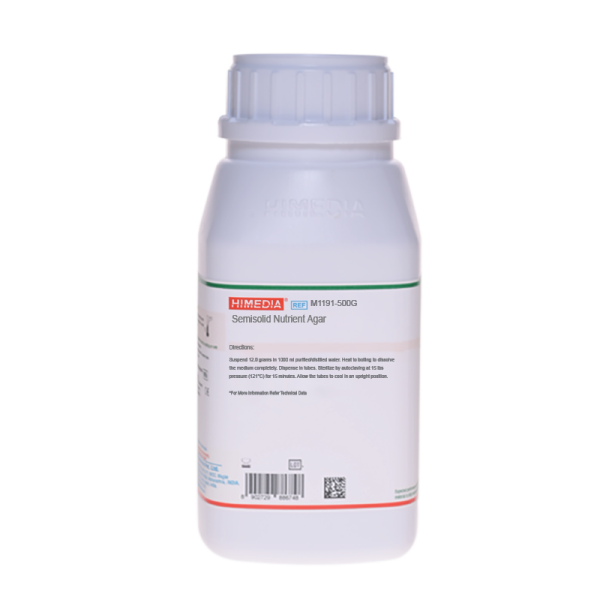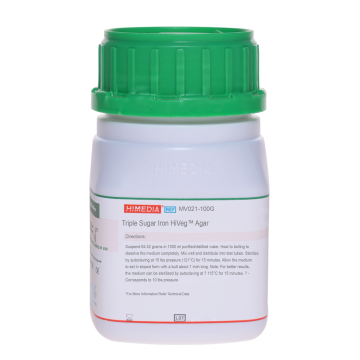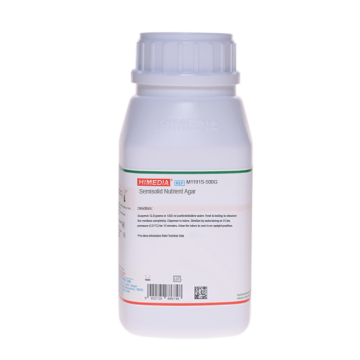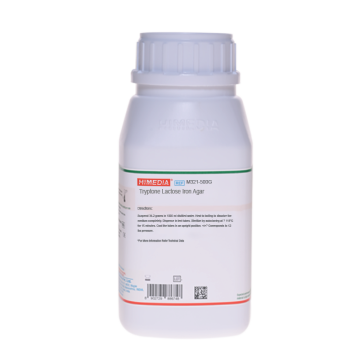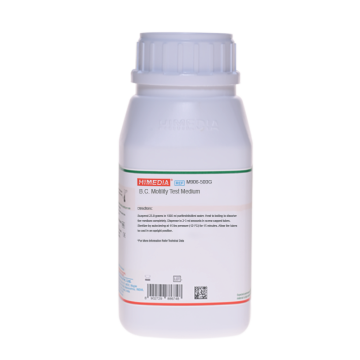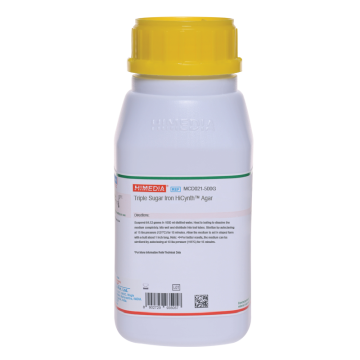 Your enquiry has been submitted
Your enquiry has been submitted
Semisolid Nutrient Agar
Intended Use
Recommended for detection of Salmonella species on the basis of motility and hydrogen sulphide (H2S) production.
Composition
| Ingredients | g/L |
|---|---|
| Peptone | 5.000 |
| HM peptone B # | 3.000 |
| Agar | 4.000 |
Final pH (at 25°C): 7.0±0.2
**Formula adjusted, standardized to suit performance parameters
# Equivalent to Beef extract
Directions
Suspend 12.0 grams in 1000 ml purified / distilled water. Heat to boiling to dissolve the medium completely. Dispense in tubes. Sterilize by autoclaving at 15 lbs pressure (121°C) for 15 minutes. Allow the tubes to cool in an upright position.
Principle And Interpretation
Nutrient Agar is a basic culture medium used in water and food studies. It is generally used for maintenance purpose or to check the purity of subcultures (1). Bacterial motility is an important determinant in making a final species identification. Tubes containing semisolid media are most often used to determine motility. Motile organisms form a diffuse zone of growth flaring out from the line of inoculation. Non-motile organisms grow along the stabline. Certain bacterial species have ability to liberate sulphur from sulphur-containing amino acids or other compounds in the form of H2S (hydrogen sulphide). Lead acetate paper strips serve as the H2S indicators (2). Semisolid Nutrient Agar couples these two tests in a single medium. It is also recommended by ISO Committee (3) for the detection of Salmonella species. Peptone and HM peptone B provide essential growth nutrients. The motile cultures grow away from stabline while non-motile grow along the stabline. After inoculation, with the test organism, insert a lead acetate paper strip (DD034) between the plug and inner wall of tube. Lead acetate strip incorporation helps to detect H2S production.
Type of specimen
Food and dairy samples; Water samples
Specimen Collection and Handling:
For food and dairy samples, follow appropriate techniques for sample collection and processing as per guidelines (4,5,6). For water samples, follow appropriate techniques for sample collection, processing as per guidelines and local standards (7). After use, contaminated materials must be sterilized by autoclaving before discarding.
Warning and Precautions :
Read the label before opening the container. Wear protective gloves/protective clothing/eye protection/ face protection. Follow good microbiological lab practices while handling specimens and culture. Standard precautions as per established guidelines should be followed while handling specimens. Safety guidelines may be referred in individual safety data sheets.
Limitations :
- Individual organisms differ in their growth requirement and may show variable growth patterns on the medium.
- Each lot of the medium has been tested for the organisms specified on the COA. It is recommended to users to validate the medium for any specific microorganism other than mentioned in the COA based on the user's unique requirement.
Performance and Evaluation
Performance of the medium is expected when used as per the direction on the label within the expiry period when stored at recommended temperature.
Quality Control
Appearance: Cream to yellow homogeneous free flowing powder
Gelling: Semisolid, comparable with 0.4% Agar gel.
Colour and Clarity of prepared medium: Light yellow coloured clear gel forms in tubes as butts
Reaction: Reaction of 1.2% w/v aqueous solution at 25°C. pH: 7.0±0.2
pH: 6.80-7.20
Cultural Response
Cultural characteristics observed after an incubation at 35-37°C for 18-24 hours.
| Organism | Inoculum (CFU) | Growth | Motility | H2S (with lead acetate strip) |
|---|---|---|---|---|
| Escherichia coli ATCC 25922 (00013*) | 50-100 | luxuriant | positive, growth away from stabline causing turbidity | negative reaction, no blackening |
| Salmonella Typhi ATCC 6539 | 50-100 | luxuriant | positive, growth away from stabline causing turbidity | positive reaction, blackening of the lower portion of the strip |
| Salmonella Enteritidis ATCC 13076 (00030*) | 50-100 | luxuriant | positive, growth away from stabline causing turbidity | positive reaction, blackening of the lower portion of the strip |
Key: (*) Corresponding WDCM numbers.
Storage and Shelf Life
Store between 10-30°C in a tightly closed container and the prepared medium at 15-30°C. Use before expiry date on the label. On opening, product should be properly stored dry, after tightly capping the bottle in order to prevent lump formation due to the hygroscopic nature of the product. Improper storage of the product may lead to lump formation. Store in dry ventilated area protected from extremes of temperature and sources of ignition. Seal the container tightly after use. Product performance is best if used within stated expiry period.
Disposal
User must ensure safe disposal by autoclaving and/or incineration of used or unusable preparations of this product. Follow established laboratory procedures in disposing of infectious materials and material that comes into contact with sample must be decontaminated and disposed of in accordance with current laboratory techniques (4,5).
Reference
- Lapage S. P., Shelton J. E. and Mitchell T. G., 1970, Methods in Microbiology, Norris J. R. and Ribbons D. W.,(Eds.), Vol. 3A, Academic Press, London.
- Koneman E. W., Allen S. D., Janda W. M., Schreckenberger P. C., Winn W. C. Jr., 1992, Colour Atlas and Textbook of Diagnostic Microbiology, 4th Ed., J. B. Lippinccott Company.
- International Organization for Standardization (ISO), 1993, Draft ISO/DIS 657.
- American Public Health Association, Standard Methods for the Examination of Dairy Products, 1978, 14th Ed., Washington D.C.
- Salfinger Y., and Tortorello M.L., 2015, Compendium of Methods for the Microbiological Examination of Foods, 5th Ed., American Public Health Association, Washington, D.C.
- Wehr H. M. and Frank J. H., 2004, Standard Methods for the Microbiological Examination of Dairy Products, 17th Ed., APHA Inc., Washington, D.C.
- Lipps WC, Braun-Howland EB, Baxter TE,eds. Standard methods for the Examination of Water and Wastewater, 24th ed. Washington DC:APHA Press; 2023.
- Isenberg, H.D. Clinical Microbiology Procedures Handbook 2nd Edition.
- Jorgensen, J.H., Pfaller, M.A., Carroll, K.C., Funke, G., Landry, M.L., Richter, S.S and Warnock., D.W. (2015) Manual of Clinical Microbiology, 11th Edition. Vol. 1.
| Product Name | Semisolid Nutrient Agar |
|---|---|
| SKU | M1191 |
| Product Type | Regular |
| Physical Form | Powder |
| Origin | Animal |
| Packaging type | HDPE |
| References | 1. Lapage S. P., Shelton J. E. and Mitchell T. G., 1970, Methods in Microbiology, Norris J. R. and Ribbons D. W., (Eds.), Vol. 3A, Academic Press, London. |
| Customized Product Available | No |



